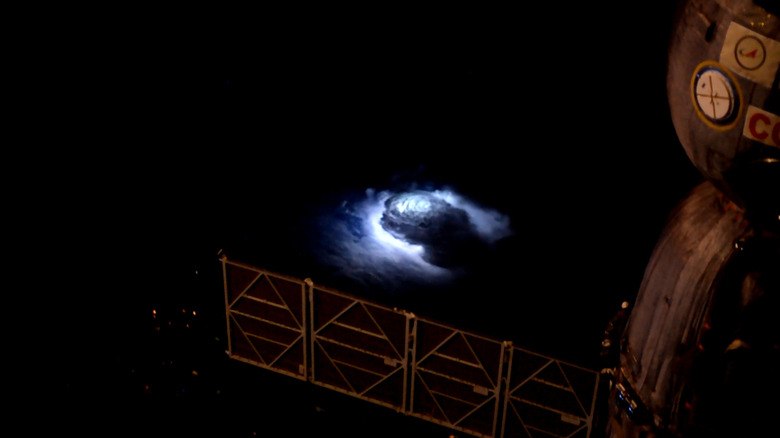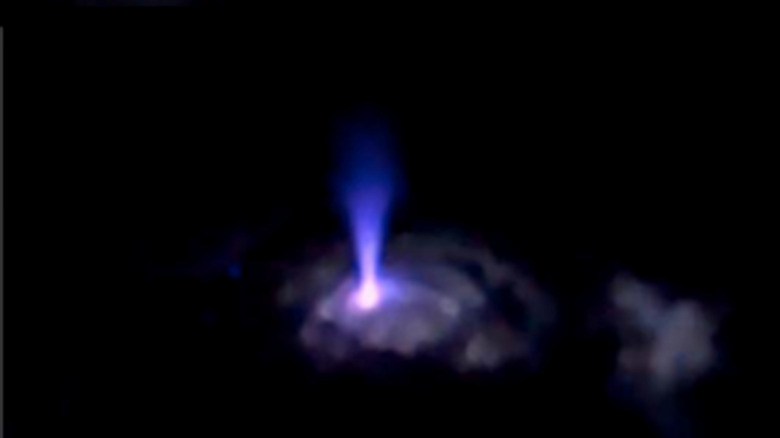How ISS Astronauts Take Incredible Photos Of Lightning From Space
Here on Earth, we're used to one primary view of thunderstorms: from the ground, looking up. You might also have seen footage of storms from various points in Earth's atmosphere, showing how water builds up into clouds and generates thunder and lightning. You sometimes see footage of large hurricanes captured by Earth-monitoring satellites from the very high orbits where they operate. But a very small number of people experience a totally different view of thunderstorms: the astronauts on board the International Space Station (ISS).
The ISS orbits around 250 miles above the Earth's surface, far above the clouds but below the 310 to 370 mile region where most Earth-observation satellites orbit. That gives the astronauts staying on the station a unique view of weather conditions on Earth, especially when it comes to large thunderstorms, which can be seen from high above.
European Space Agency (ESA) astronaut Andreas Mogensen, currently on board the ISS, previously photographed a thunderstorm from the station when he was on his first mission there in 2015. He observed blue discharges above the thunderclouds, captured in an experiment called Thor, after the Norse god of thunder.
Now, he will attempt to capture another view with a new camera in an experiment with the Danish space research institute DTU Space.
A camera for a thunderstorm
To try to capture a thunderstorm image again, Mogensen will use a camera on the space station, which looks out of a rounded window called a cupola. But rather than using only the standard camera, an additional camera with special qualities is added.
The Davis camera is an event camera that automatically responds when there is a significant change in brightness. Instead of pushing a button to take an image and capturing whatever is happening at that moment, the Davis camera responds when something changes in its view — in this case, hopefully catching the events of a thunderstorm in action.
"We are excited to have Andreas Mogensen look for thunderstorms with the new event camera. Last time, he captured a blue jet, so we hope for even more pictures over his six-month stay. This will be the first time an event camera is used to observe lightning events by an astronaut," said DTU Space senior researcher Olivier Chanrion.
The Davis camera can respond extremely fast, collecting data equivalent to 100,000 images per second. That should enable it to capture the very short discharges of lightning that occur between the clouds but don't reach Earth. These events, called transient luminous events (TLEs), include blue jets of lightning shooting up from clouds and into space and flashes of red light called sprites.
Why study thunderstorms from space
You might think we know all about thunderstorms, given how often we observe them from Earth. But that's not the case. There is a lot about how storms form and grow that we are still learning about, especially in the upper parts of Earth's atmosphere.
Scientists are particularly interested in learning how thunderstorms can interact with some elements in the higher parts of the atmosphere, such as ozone, a type of oxygen molecule known as a greenhouse gas, because its presence raises the planet's surface temperature. Ozone is essential as it filters out harmful ultraviolet (UV) rays from the sun by absorbing the UV radiation, allowing life to thrive on Earth's surface.
"The interaction between these lightning events and the upper atmosphere is not fully understood," said researcher Oliver Chanrion. "Thanks to Thor, we know there are more than what we expected. With Thor-Davis, we have the opportunity to analyze and quantify their impact and to check to which extent they are associated with overshooting thundercloud tops that inject greenhouse gases and aerosols in the stratosphere. We think it is important to better understand that in a changing climate."

